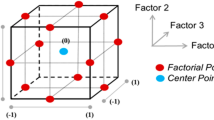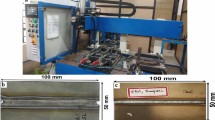Abstract
In this study, a theoretical approach of the remote welding process has been developed and discussed. The study obtains numerically the melting boundaries of different heat source angles, based on an analytical calculation of the keyhole depth. The approach considers the dominant process parameters of the laser power, the welding speed and the inclination of the laser beam on the workpiece surface. The geometrical particularities of the beam spot, due to the different inclination of the laser beam upon the processing plane, have also been considered in a previous study of the authors. The theoretical results present good agreement when compared with experimental data obtained from a remote welding system (RWS) on lap welding of AISI 304 stainless steel, thin sheets.
Similar content being viewed by others
Abbreviations
- RWS:
-
remote welding system
- FEA:
-
finite element analysis
- A :
-
the material’s absorptivity,
- b :
-
the keyhole radius at direction vertical to the laser beam propagation direction (m),
- C P :
-
the material’s specific heat (J/kgK),
- C Pair :
-
the specific heat of air (J/kgK),
- d :
-
the keyhole depth along the direction of the laser beam propagation (m),
- H:
-
the material’s enthalpy (J/kg),
- \( \overline{h} _{{forced}} \) :
-
the forced convection film coefficient for the upper surface of the upper sheet (W/m2K),
- \( \overline{h} _{{free,LH}} \) :
-
the free convection film coefficient for the lower, horizontal surfaces of the sheets (W/m2K),
- \( \overline{h} _{{free,I}} \) :
-
the free convection film coefficient for the interface surface between the sheets (W/m2K),
- \( \overline{h} _{{free,UH}} \) :
-
the free convection film coefficient for the upper, horizontal surface of the lower sheet (W/m2K),
- \( \overline{h} _{{free,V}} \) :
-
the free convection film coefficient for the vertical surfaces of the sheets (W/m2K),
- k :
-
the material’s thermal conductivity (W/mK),
- k air :
-
the thermal conductivity of air (W/mK),
- L m :
-
the material’s latent heat of melting (J/kg),
- L v :
-
the material’s latent heat of vaporisation (J/kg),
- n :
-
the coordinate normal to an infinitesimal keyhole surface,
- P :
-
the provided laser power (W),
- P max :
-
the maximum output laser power (W),
- Q :
-
the applied volume heat load (W/m3),
- Q′ :
-
the applied volume heat load (W/m2),
- \( r_{f} \prime \prime {\left( {z_{r} \prime } \right)} \) :
-
the laser beam radius as a function of distance, \( z_{r} \prime \) (m),
- \( r_{{f,\phi }} \prime \prime \) :
-
the laser beam radius at distance \( z_{{r,\phi }} \) from the focal plane (m),
- \( r_{{f_{0} }} \) :
-
the Gaussian laser beam radius at the focal plane (m),
- \( r_{{f_{0} }} \prime {\left( \phi \right)} \) :
-
major semi-axis of the elliptic laser beam spot at zero focal depth (m),
- T :
-
the temperature at any arbitrary point (K),
- T 0 :
-
the ambient temperature (K),
- T m :
-
the material’s melting temperature (K),
- T v :
-
the material’s vaporization temperature (K),
- u :
-
the welding speed (m/s),
- u air :
-
the speed of the air jet (m/s),
- x, y, z :
-
the Cartesian co-ordinates of the local co-ordinate system at the keyhole (m),
- x′, y′, z′ :
-
the Cartesian co-ordinates of a rotated coordinate system around axis y about angle φ, of the local keyhole co-ordinate system (m),
- x E , y E :
-
the Cartesian coordinates of an arbitrary point of the elliptical beam spot’s boundary (m),
- \( z_{r} \prime \) :
-
the distance from the focal plane along the laser beam propagation (m),
- \( z_{{r,\phi }} \prime \) :
-
the distance of the plane parallel to the focal plane that intersects with the laser beam’s waist at the surface of the workpiece for a given angle φ (m),
- ε:
-
the material’s emissivity,
- δ f :
-
the position of the focal plane in respect to the processing plane (m),
- λ :
-
the wavelength of the laser (m),
- ν air :
-
the kinematic viscosity of air (m2/s),
- ρ :
-
the material’s density (kg/m3),
- ρ air :
-
the density of air (kg/m3),
- φ :
-
the supplementary angle to the incidence angle (Degrees),
- φ w :
-
the weld angle (Degrees).
References
Duley WW (2000) Laser welding. Wiley, New York
Chryssolouris G (1991) Laser machining-theory and practice. Springer, Berlin Heidelberg New York
Ready JF (Editor in chief), Farson DF (Associate Editor) (2001) LIA Handbook of laser materials processing. Laser Institute of America, USA
Ream S (1993) Laser scanner lap welding. Proceedings of the International Body Engineering Conference, Advanced Technologies & Processes: pp 44–47
Macken J (1996) Remote laser welding. Proceedings of the International Body Engineering Conference, Advanced Technologies & Processes: pp 11–15
Rath W, Lingner M (2002) Remote laser welding system using slab laser technology: process data and technical applications. Proc. of the 10th Annual Automotive Laser Applications Workshop, March 12–13, MI: pp 119–127
Tsoukantas G, Salonitis K, Stournaras A, Stavropoulos P, Chryssolouris G (2006) On optimal design limitations of generalized two-mirror remote beam delivery laser systems: the case of remote welding. The International Journal of Advanced Manufacturing Technology, DOI 10.1007/s00170-005-0400-7
Goebel G, Havrilla D, Wetzig A, Beyer E (2000) Laser welding with long focal length optics. Proceedings of the ICALEO 2000: A/28–37
Thomy C, Grupp M, Seefeld T, Sepold G, Vollertsen F (2004) Remote welding of steel and aluminium alloys at high laser power. Proceedings of the LANE 2004: pp 211–222
Beyer E, Klotzbach A, Fleischer V, Morgenthal L (2003) Nd:YAG-remote welding with robots. Proceedings of the Second International WLT-Conference on Laser in Manufacturing 2003, Munich: pp 367–373
Klotzbach A, Morgenthal L, Schwarz T, Fleischer V, Beyer E (2001) Laser welding on the fly with Coupled Axes Systems. Proceedings of the ICALEO 2001, Jacksonville, Florida
Tsoukantas G, Salonitis K, Stavropoulos P, Chryssolouris G (2003) An overview of 3D Laser Materials’ Processing Concepts. 3rd GR-I International Conference on New Laser Technologies and Applications, Proceedings of SPIE, Vol. 5131: pp 224–228
Beyer E, Klotzbach A, Fleischer V, Morgenthal L (2003) Nd:YAG-remote welding with robots. Proceedings of the Second International WLT-Conference on Laser in Manufacturing 2003, Munich: pp 367–373
Becker W, Beck M, Bernhardt R (2004) Potential of robot-guided remote laser welding. Proceedings of the LANE 2004: pp 201–210
Emmelmann C (2005) Laser remote welding - status and potential for innovations in industrial production. Proceedings of the Third International WLT-Conference on “Lasers in Manufacturing” (LIM 2005), München
Stemmann J, Emmelmann C, Albrecht T (2005) Repeatability of robot-based Laser Remote Welding Systems. Proceedings of the Third International WLT-Conference on “Lasers in Manufacturing” (LIM 2005), München
Stemmann J, Emmelmann C (2005) High performance scanner for remote welding with Nd:YAG Lasers. Proceedings of the ICALEO 2005: P502
Amara EH, Bendib A (2002) Modeling of vapour flow in deep penetration laser welding. J Phys D Appl Phys 35:272–280
Ho CY, Wei PS Energy absorption in a conical cavity truncated by spherical cap subject to a focused high - intensity beam. Int J Heat Mass Transfer 40(8):1895–1905
Solana P, Negro G (1997) A study of the effect of multiple reflections on the shape of the keyhole in the laser processing of materials. J Phys D Appl Phys 30:3216–3222
Fabbro R, Chouf K (2000) Keyhole modelling during laser welding. J Appl Physi 87(9):4075–4083
Lee JH, Sung HK, Farson DF, Choong DY (2002) Mechanism of keyhole formation and stability in stationary laser welding. J Phys D Appl Phys 35:1570–1576
Jouvard JM, Girard K, Perret O (2001) Keyhole formation and power deposition in Nd: YAG laser spot welding. J Phys D Appl Phys 34:2894–2901
Xiang Zhong J, Lijyn L, Zhang Y (2002) A study on Fresnel absorption and reflections in the keyhole in deep penetration laser welding. J Phys D Appl Phys 35:2304–2310
Xiang Zhong J, Li LJ (2003) A conduction model for deep penetration laser welding based on an actual keyhole. Opt Laser Technol 35:5–12
Kaplan A (1994) A model of deep penetration laser welding based on calculation of the keyhole profile. J Phys D Appl Phys 27:1805–1814
Akhter R, Davis M, Dowden J, Kapadia P, Ley M, Steen WM (1989) A method for calculating the fused zone profile if laser keyhole welds. J Phys D Appl Phys 21:23–28
Solana P, Ocana JL (1997) A mathematical model for penetration laser welding as a free-boundary problem. J Phys D Appl Phys 30:1300–1313
Lankapalli KN, Tu JF, Gartner M (1996) A model for estimating penetration depth of laser welding processes. J Phys D Appl Phys 29:1831–1841
Lampa C, Kaplan AFH, Powell J, Magnusson C (1997) An Analytical thermodynamic model of laser welding. J Phys D Appl Phys 30(9):1293–1299
Pecharapa W, Kar A (1997) Effects of phase changes on weld pool shape in laser welding. J Appl Physi 30:3322–3329
Chang WS, Na SJ (2002) A study on the prediction of the laser weld shape with varying heat source equations and the thermal distortion of a small structure in micro-joining. J Mater Process Technol 120:208–214
Sonti N, Amateau MF (1989) Finite-element modelling of heat flow in deep-penetration laser welds in Aluminium Alloys. Numer Heat Transf A Appl 16:351–370
Mueller R (1994) A model for predicting keyhole and fusion zone depths in blind keyhole welding. Proceedings of the ICALEO 2004, pp 509–518
Cho S-K, Yang Y-S, Son K-J, Kim J-Y (2004) Fatigue strength in laser welding of the lap joint. Finite Elem Anal Des 40:1059–1070
Tsirkas SA, Papanikos P, Kermanidis T (2003) Numerical simulation of the laser welding process in butt-joint specimens. J Mater Process Technol 134:59–69
Ferro P, Bonollo F, Tiziani A (2005) Laser welding of copper-nickel alloys: a numerical and experimental analysis. Sci Technol Weld Join 10:299–310
Carmignani C, Mares R, Toselli G (1999) Transient finite element analysis of deep penetration laser welding process in a single glass butt-welded thick steel plate. Comput Methods Appl Mech Eng 179:197–214
Touloukian YS, Kirby RK, Taylor RE, Desai PD (1975) Thermophysical properties of matter, V 12. IFI/Plenum, New York
Wilthan B, Cagran C, Pottlacher G (2003) A comparison of enthalpy values of selected metals obtained by pulse-heating and differential-scanning-calorimetry. 15th Symposium on Thermophysical Properties, Boulder, Colorado, U.S.A., pp 22–27
Incropera FP, Dewitt DP (1996) Fundamental of mass and heat transfer, 4th edn. Wiley, New York
Yang YS, Lee SH (1999) A study on the joining strength of laser spot welding for automotive applications. J Mater Process Technol 94:151–156
ISO 13919-1, “Welding - Electron and laser-beam welded joints - Guidance on quality levels for imperfections - Part 1: Steel”, First edition 1996-08-01
Acknowledgement
The work reported, was partially supported by the EU funded project: G1RD-2000-00332, “Highly Efficient & Flexible Remote Welding Systems for Advanced Welded Structures-REMOWELD”.
Author information
Authors and Affiliations
Corresponding author
Rights and permissions
About this article
Cite this article
Tsoukantas, G., Chryssolouris, G. Theoretical and experimental analysis of the remote welding process on thin, lap-joined AISI 304 sheets. Int J Adv Manuf Technol 35, 880–894 (2008). https://doi.org/10.1007/s00170-006-0767-0
Received:
Accepted:
Published:
Issue Date:
DOI: https://doi.org/10.1007/s00170-006-0767-0




